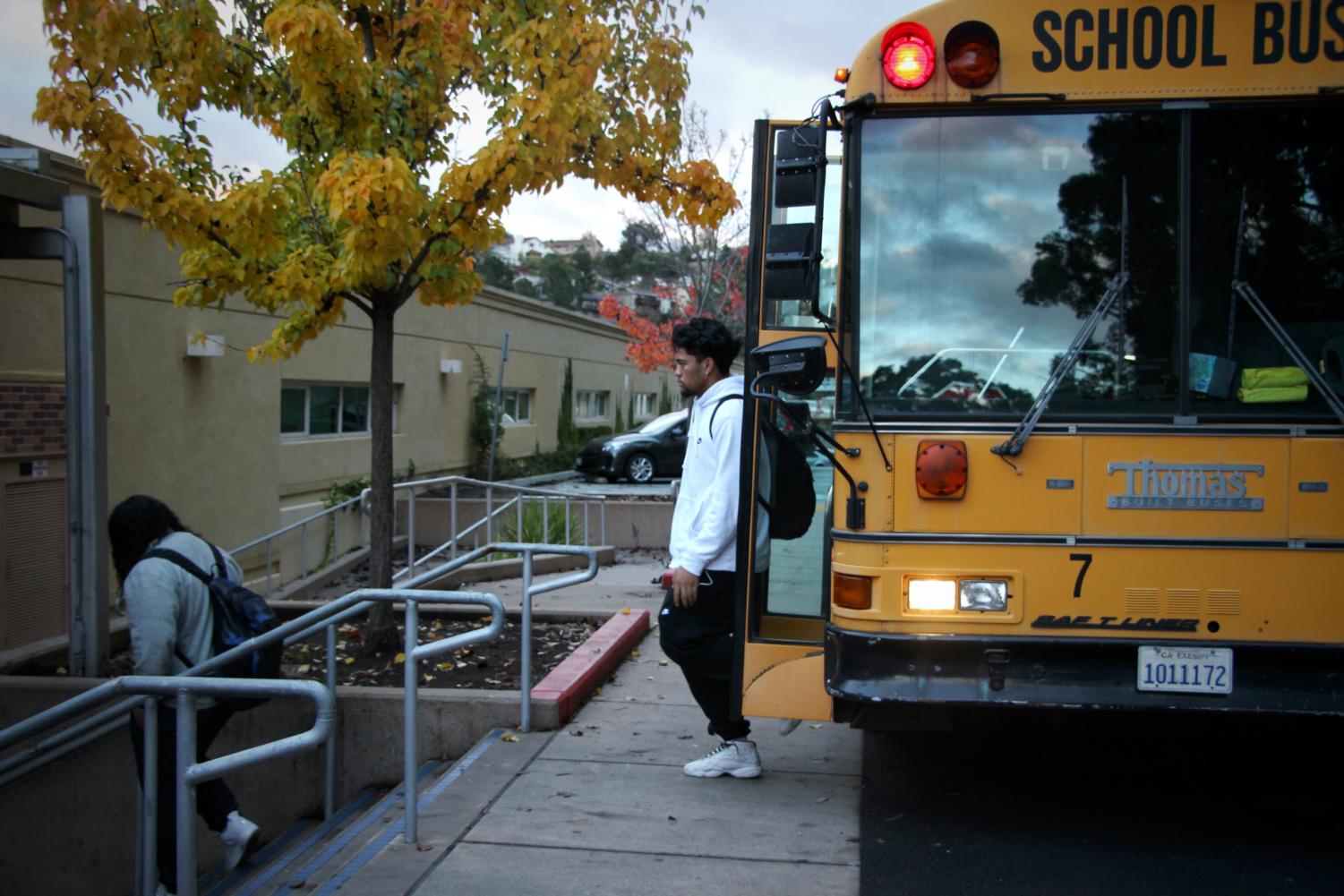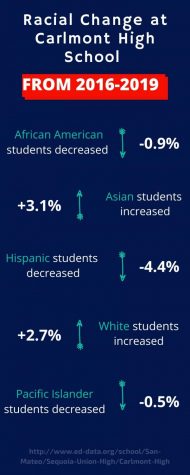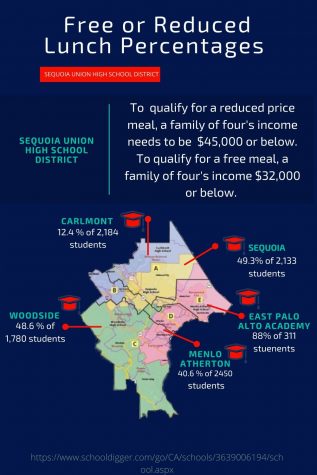
Twitter: @marren_niamh

Twitter: @velschow


May 17, 2020

When most people hear the word diversity, many think about different racial ethnicities. One thing that is often talked about but never changed is how certain privileges or disadvantages are based on skin color.
Such may be present at Carlmont High School, as some believe that the school struggles to stress the importance of racial diversity in a high school environment.
The privileges that come with the lack of diversity at a school is concerning to most educators. Principal Ralph Crame has been working at Carlmont for 13 years and has seen a drastic decline in diversity over time.
“Many people are concerned. I see it as a lack of potential education, and I think any school benefits more when there is more diversity,” Crame said.
Carlmont is a part of the Sequoia Union High School District, with a total student population of 9,293. Carlmont, being one of the most populated schools in the district, is also the least diverse.
According to PrepScholar, compared to other schools in the district, Carlmont has a small population of Hispanics at 15.2%, while other schools, such as Woodside and Sequoia High Schools, have over 50% Hispanic students. Likewise, the Carlmont minority percentage has continued to drop throughout the years.

The number of minority students at Carlmont falls every year, partly due to the Belmont and San Carlos community’s housing prices.
According to Zillow, the average home value in this area is approximately $1.7 million. This housing price for most families is unattainable, especially for families that make a low income.
The average income for families that live in East Palo Alto (EPA) is below $60,000, about $30,000 below the average salary in the Bay Area. Housing prices in EPA are, on average, $900,000. This price may still be high, but compared to $1.7 million, it is more affordable.
The income of families in EPA compared to Carlmont coincides with the amount of free and reduced lunch recipients at each high school. Generally, students who qualify for free or reduced lunches make an income of $45,000 or below.
While schools such as East Palo Alto Academy provide such lunches to approximately 88% of their student population, only 12.4% of Carlmont students qualify.
Due to the low income of families in EPA, schools aren’t able to receive a large amount of fundraising. Forty years ago, this was a significant factor in why schools weren’t able to run.
Beginning in the 1980s, after Ravenswood High School in EPA shut down due to low enrollment and financial constraints, the district decided to distribute the students that were attending Ravenswood to the other schools in the district, including Carlmont. This diversified Carlmont, but the community and families from EPA wanted to put an end to busing and have their teenagers attend a closer school, Menlo-Atherton (M-A).
In 2013, the district board voted to end the busing of students in a 4-1 ruling. Students from EPA could now request a transfer to M-A as incoming ninth-graders, placing them before students applying to M-A through the district’s open enrollment system. The open enrollment system allows any student who lives in the Sequoia Union High School District to transfer to any of the schools within the district, provided there is space.
It is a 50-minute round trip bus ride both ways from EPA to M-A. In contrast, a roundtrip bus ride between EPA and Carlmont takes around three hours every day.
A sophomore from Carlmont High School, Sosefo Ahofono, is one of those who makes the round trip bus ride beginning at 5:30 a.m. He often struggles to finish the homework due to this early-morning routine.
Even though the commute from EPA to Carlmont is lengthy, the opportunities it presents continues to draw students away from East Palo Alto Academy (EPAA). For example, according to Max Prep, EPAA lacks several sports teams. The numerous sports teams that Carlmont has to offer are reasons why many students leave their community in EPA.
Another reason why students leave EPA is because of the extensive academic opportunities elsewhere.
“Carlmont is a good environment to learn and focus on your future as well as to learn how to work with others as you would as an adult,” Ahofono said.
Aside from transferring, another option for EPA students can be found right in their backyards. Approximately 320 students decided to go to EPAA for the 2019-20 school year, a small learning community within the district.
The principal of EPAA, Amika Guillaume, stresses three main factors throughout a student’s four years at EPAA. The first factor is “Bulldog love.”
“This idea that you have to love yourself, you have to love your community, and you must love from where you come from,” Guillaume said.
Many students at EPAA are first-generation students who come from various backgrounds, including poverty and immigrant families. To learn that they should be proud of their background, no matter where their parents came from, is essential for all students.
The second idea is “Bulldog attitude,” which showcases a love of learning and how learning should be a priority in students’ lives. When students are deciding if they want to go to college or not, the administration explains to them that they have a privilege to learn for the next four years and focus on studies to prepare them for the future better.
“This is very hard for first-generation kids to understand because their families are asking, ‘Why aren’t you helping with rent?’ and saying that they are not going to be able to find a real job after college,” Guillaume said.
In contrast, many students at Carlmont have never doubted that they will attend college after high school because that is what their parents have instilled in them since kindergarten. According to Guillaume, college has not crossed many EPA students’ minds as they enter high school because many families are focused on putting food on the table every night rather than getting their children into elite colleges.
The last idea stressed is “Bulldog power,” when eighth-graders and incoming ninth-graders are taken to a local food bank and help those in need. This idea leaves students with a sense of power and shows them that they can impact the world and be grateful for what they have.
Guillaume sets up an environment that directly responds to the struggles of the students and the community within EPA that students and families at Carlmont may not experience. Generally, Carlmont students are born with opportunities and expectations, while EPA students find themselves lacking some of those opportunities.
“The challenge is really to get people to understand other people’s perspectives, whether that is a religious or racial based. Just getting people to understand other people’s points of view and where they are coming from is the biggest issue around diversity,” Crame said.

